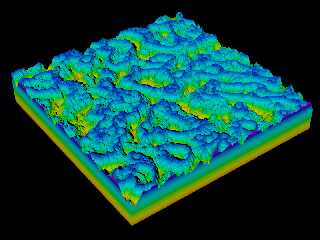 |
 |
|
 |
|
 |
|  |
|  |
|
 |
|
 |
|  |
|  |
|
 |
To illustrate our discussion about height field function with wave deformations,
and as part of POV-Ray popularization, I've rendered few most tasty examples:
https://github.com/syanenko/Height-fields
--
YB
Post a reply to this message
Attachments:
Download 'hf_triangle_hsv.png' (374 KB)
Preview of image 'hf_triangle_hsv.png'

|
 |
|  |
|  |
|
 |
From: Jörg "Yadgar" Bleimann
Subject: Re: Height field function illustrations
Date: 18 Feb 2023 09:08:42
Message: <63f0dbea$1@news.povray.org>
|
|
 |
|  |
|  |
|
 |
Hi(gh)!
On 18.02.23 14:25, yesbird wrote:
> To illustrate our discussion about height field function with wave deformations,
> and as part of POV-Ray popularization, I've rendered few most tasty examples:
>
> https://github.com/syanenko/Height-fields
> --
> YB
Looks like a ridged Perlin function... as I want to generate Earth-like
planets with a realistic height distribution, since a long time I'm
looking for a function yielding long branching mountain chains but also
broad plains at intermediate height levels, and finally deep low basins.
Did not find it yet - my experiments with ridged_hf and related
functions always just produced continents with massive elevations but
narrow to non-existent coastal plains...
See you in Khyberspace!
Yadgar
Post a reply to this message
|
 |
|  |
|  |
|
 |
|
 |
|  |
|  |
|
 |
"yesbird" <nomail@nomail> wrote:
> To illustrate our discussion about height field function with wave deformations,
> and as part of POV-Ray popularization, I've rendered few most tasty examples:
>
> https://github.com/syanenko/Height-fields
> --
> YB
Yes, those are juicy - I will agree that the color maps you are choosing work
very well and achieve a good look.
I think if you really want to see some more "WOW" - then look into applying sslt
- sub-surface light transport. Then some of those would look even more amazing!
Post a reply to this message
|
 |
|  |
|  |
|
 |
|
 |
|  |
|  |
|
 |
> Yadgar
You need to check out SimonDev
https://www.youtube.com/watch?v=HIYs7Hoq2yQ
and
Sebastian Lague
https://www.youtube.com/@SebastianLague/videos
as well as learning how select (A, B, C, D) can help you achieve everything that
you want.
You would also be well-served to learn about smoothstep
https://www.youtube.com/watch?v=60VoL-F-jIQ
and other easing functions and activation functions.
Don't look for "the perfect function. Take a (few) function(s) and mold them to
suit your specific needs.
Post a reply to this message
|
 |
|  |
|  |
|
 |
|
 |
|  |
|  |
|
 |
Hi, Yadgar !
Landscapes always attracted me, I believe that key to realism is the combination
of different noise types and other methods, like this one for example:
https://expreg.org/amsi/C/articles/fbelhadj_200512.pdf
My lovely C4D has best library of noise functions, that can be layered, I like
playing with them, combining with different logical operations, and getting very
interesting and unexpected results:
https://developers.maxon.net/docs/Cinema4DPythonSDK/html/types/noise.html
Btw, it' good idea, will explore noises in POV this evening !
Happy landscaping,
--
YB
Post a reply to this message
|
 |
|  |
|  |
|
 |
|
 |
|  |
|  |
|
 |
> I think if you really want to see some more "WOW" - then look into applying sslt
> - sub-surface light transport. Then some of those would look even more amazing!
Thanks, good idea, I used SSS in a VRay and Redshift, now I'm intrigued how it
implemented in POV.
--
YB
Post a reply to this message
|
 |
|  |
|  |
|
 |
|
 |
|  |




![]()